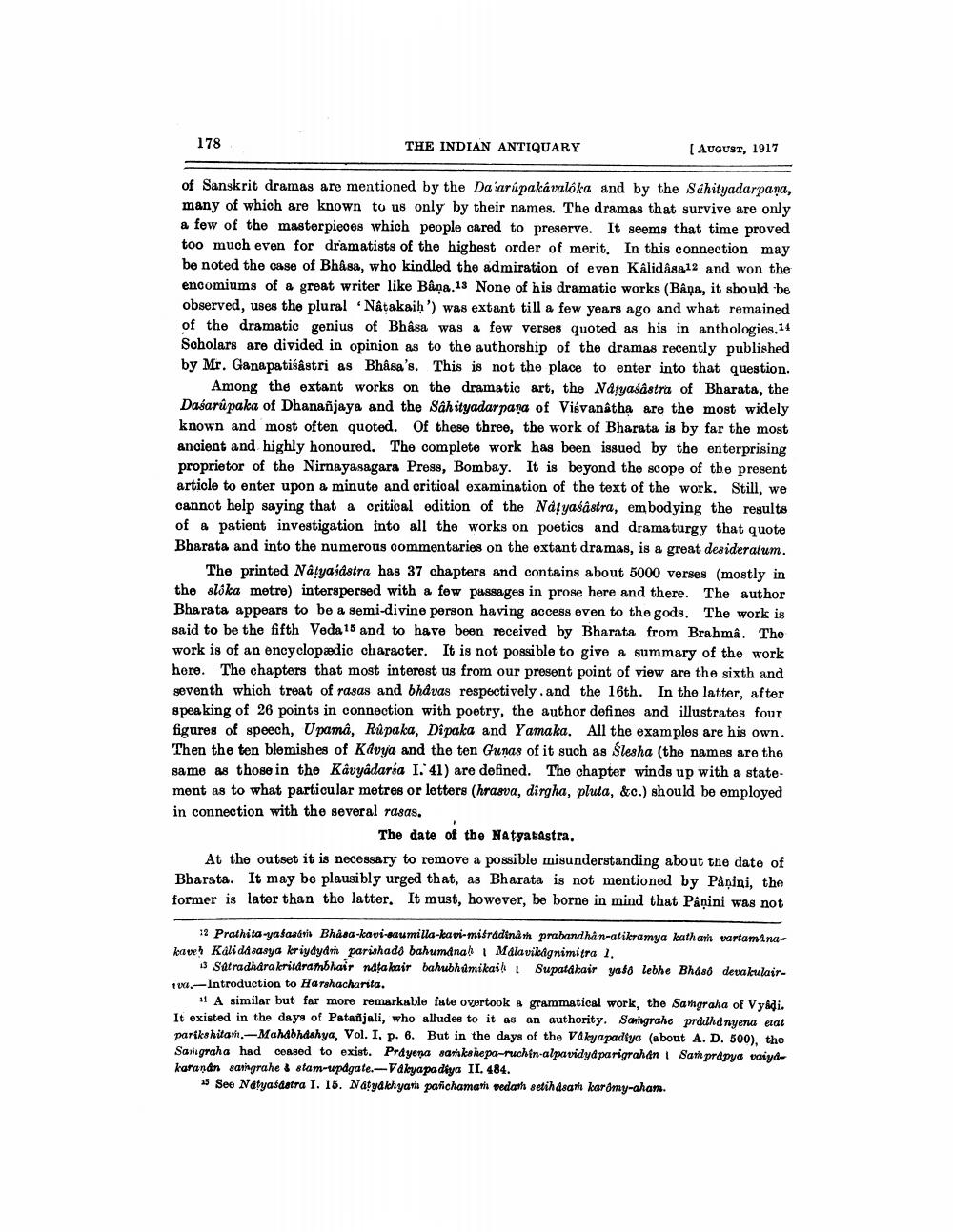________________
178
THE INDIAN ANTIQUARY
(AUGUST, 1917
of Sanskrit dramas are mentioned by the Daiarúpakávalóka and by the Sahityadarpana, many of which are known to us only by their names. The dramas that survive are only a few of the masterpieces which people cared to preserve. It seems that time proved too much even for dramatists of the highest order of merit. In this connection may be noted the case of Bhâsa, who kindled the admiration of even Kalidasa12 and won the encomiums of a great writer like Bâņa. 13 None of his dramatic works (Bâņa, it should be observed, uses the plural Nâtakaih') was extant till a few years ago and what remained of the dramatic genius of Bhâsa was a few verses quoted as his in anthologies.14 Scholars are divided in opinion as to the authorship of the dramas recently published by Mr. Ganapatiśâstri as Bhåsa's. This is not the place to enter into that question.
Among the extant works on the dramatic art, the Natyaśāstra of Bharata, the Dasarú paka of Dhananjaya and the Sahityadar para of Visvanatha are the most widely known and most often quoted. Of these three, the work of Bharata is by far the most ancient and highly honoured. The complete work has been issued by the enterprising proprietor of the Nirnayasagara Press, Bombay. It is beyond the scope of the present article to enter upon a minute and oritioal examination of the text of the work. Still, we cannot help saying that a critioal edition of the Natyasastra, embodying the results of a patient investigation into all the works on poetics and dramaturgy that quote Bharata and into the numerous commentaries on the extant dramas, is a great desideratum.
The printed Natyajdstra has 37 chapters and contains about 5000 verses (mostly in the slika metre) interspersed with a few passages in prose here and there. The author Bharata appears to be a semi-divine person having access even to the gods. The work is said to be the fifth Veda 15 and to have been received by Bharata from Brahma. The work is of an encyclopædic character. It is not possible to give a summary of the work here. The chapters that most interest us from our present point of view are the sixth and seventh which treat of rasas and bhavas respectively and the 16th. In the latter, after speaking of 26 points in connection with poetry, the author defines and illustrates four figures of speech, Upamâ, Rúpaka, Dipaka and Yamaka. All the examples are his own. Then the ten blemishes of Kavya and the ten Gunas of it such as slesha (the names are the same as those in the Kavyadarsa 1. 41) are defined. The chapter winds up with a statement as to what particular metres or letters (hrasva, dirgha, pluta, &c.) should be employed in connection with the several rasas.
The date of the Natyabastra. At the outset it is necessary to remove a possible misunderstanding about the date of Bharata. It may be plausibly urged that, as Bharata is not mentioned by Påņini, the former is later than the latter. It must, however, be borne in mind that Panini was not
12 Prathita yatasari Bhasa-kavi-saumilla-kavi-misradina i prabandhá n-atikramya katharis wartaminakaveh Kali da sasya kriyayam parishads bahumanah | Malavikagnimitra 1.
13 Satradhara kritdrambhair ndja kair bahubhumikaiki Supaldkair yas) lebhe Bhdad devalulairI.-Introduction to Harshacharita.
11 A similar but far more remarkable fate overtook & grammatical work, the Sathgraha of Vyadi. It existed in the days of Patanjali, who alludes to it as an authority. Sangrahe prodha nyena etat parikshita.-Mahabhashya, Vol. I, p. 6. But in the days of the Vakyapadiya (about A. D. 500), the Sailgraha had consed to exist. Prayena sankahepa-ruchin-alpavidyd parigrahan Sam prdpya taiydkatanan sangrahe & stam-updgate.- Vakya pa diya II. 484.
15 See Natyasdatra I. 15. Natyakhyari patichamam vedat setihdsart karmy-aham.




